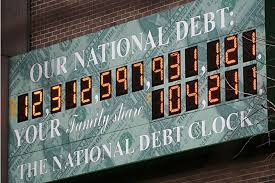What is Money?
Money can be silver or gold coins, a piece of paper, sea shells, beads. Money can also be digital, bits of information assigning value to your saving bank account or checking account? Money can be anything that we assign value to. Money is used as a means of exchange (buying goods).
What is Fiat Money:
Fiat money is currency that a government has declared to be legal tender, but is not backed by a physical commodity.
The value of fiat money is derived from the relationship between supply and demand rather than the value
of the material that the money is made of. Historically, most currencies were based on physical commodities such as gold or silver, but fiat money is based solely on faith. Fiat is the Latin word for "it shall be".
Because fiat money is not linked to physical reserves, it risks becoming worthless due to hyperinflation
and or monetization. A perfect example of monetization and the consequences of monetization is the Weimar Republic.
If people or other nations lose faith in a nation's paper currency, like the dollar bill, the money will no longer hold any value and many people would be wiped out financially because money, and money market accounts would be worthless or greatly diminished
Most modern paper currencies are fiat currencies including the dollar, have no intrinsic value and are used solely as a means of payment.
G Edward Griffin - Creature From Jekyll Island
US Debt Crisis Explained
US Debt
Here are the facts:
In 1980, America was the largest creditor nation in all of recorded history. Three short decades later, America is the greatest debtor nation in all of world history. The meteoric rise in America’s national debt has been largely due to deficit spending.
- From 1980-1986, the national debt did in just six short years under President Ronald Reagan what it had taken nearly 200 years to do: it doubled to $2 trillion
- When Reagan’s eight years of massive deficit spending were finally over, the national debthad soared a whopping 184%.
- UNDER George Bush Sr. the national debt grew by a whopping 55% in just four short years.
- By the end of 1992, the national debt had grown to a total of $4 trillion.
- In President Bush’s first term in office, total government spending grew by 33 percent.
- By 2002, America’s national debt stood at a staggering total of $6 trillion.
- From 2002 to 2004, the debt grew by another $1 trillion for a total of $7 trillion.
- By 2005, the total debt reached $8 trillion.
- In 2007, the debt had risen to $9 trillion.
- And in September 2008, the total national debt crossed the $10 trillion mark amid the worst financial crisis since the Great Depression.
- During George W. Bush’s combined eight years as President, the total national debt increased by an astounding 86%, growing by an average of $662 billion each year he was in office.
- In the wake of the Bush administration, the American public was growing tired of the economic and political status quo. In 2009, a new promise of “change” was in the air. Barack Obama rode this sweeping public demand for “change” right into the White House. Little did the public realize that regardless of which political party is in the White House, you still get the same results.
- During President Obama's time in office, America’s national debt has skyrocketed from $10.9 trillion to its current level of $17 trillion.
- As any casual observer can see, America’s national debt is not shrinking — despite the promises made by either political party to reduce the debt.
(Click On The Image Above)
The era of “big government” never went away. As the size of government increases so do your taxes and obligations. Also, as the government grows, your freedoms guaranteed by the US Constitution and the Bill of Rights diminishes greatly.
Why Savers Are Losers!
Acquire Real Assets
Real Assets are physical or tangible assets that have value, due to their substance and properties. Real assets include precious metals, commodities, real estate, agricultural land and oil. They are appropriate for inclusion in most diversified portfolios - with their proportion dependent on the investor's risk tolerance and preferences - because of their relatively low correlation with financial assets, such as stocks and bonds. They are particularly well-suited for inflationary times, because of their tendency to outperform financial assets during such periods.
Real
assets are a separate and distinct asset class from financial assets,
whose value is derived from a contractual claim on an underlying asset,
which may be real or intangible. For example, commodities and property
are real assets, but commodity futures and ETFs, as well as real estate
investment trusts, constitute financial assets whose value depends on
the underlying real assets.
Higher carrying and storage costs, increased transaction fees and lower liquidity, are some common drawbacks of real assets in relation to financial assets.
To survive and to thrive in today's rapidly changing world everyone should acquire as many REAL diversified assets as possible.
Higher carrying and storage costs, increased transaction fees and lower liquidity, are some common drawbacks of real assets in relation to financial assets.
To survive and to thrive in today's rapidly changing world everyone should acquire as many REAL diversified assets as possible.
Make It! Keep It! Enjoy it!
Wealth Preservation Strategies:
- Have more than one source of income
- Pay-off ALL your debts, including mortguage
- Have at least $2,000 on hand for emergncies
- Acquire Real Assets: Real Estate, gold, silver, natural resources, etc.
.



